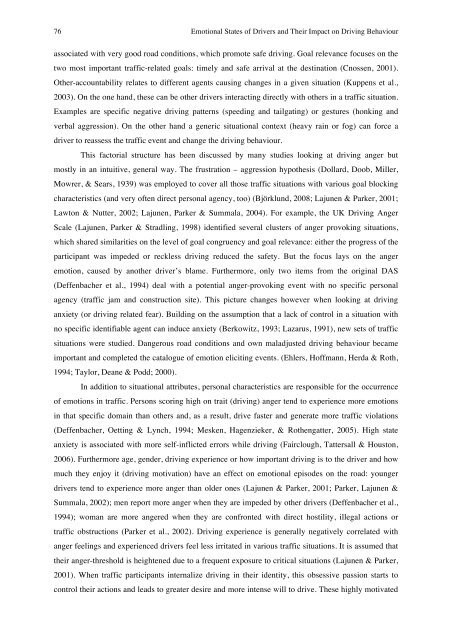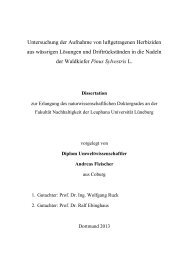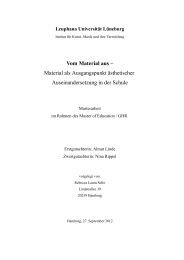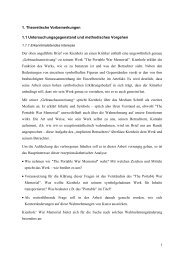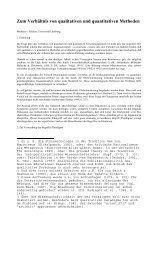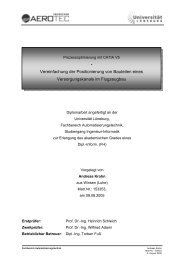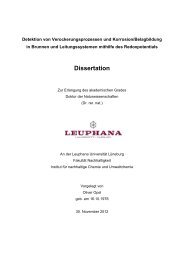Determinants of Emotional Experiences in Traffic Situations ... - OPUS
Determinants of Emotional Experiences in Traffic Situations ... - OPUS
Determinants of Emotional Experiences in Traffic Situations ... - OPUS
You also want an ePaper? Increase the reach of your titles
YUMPU automatically turns print PDFs into web optimized ePapers that Google loves.
76 <strong>Emotional</strong> States <strong>of</strong> Drivers and Their Impact on Driv<strong>in</strong>g Behaviour!<br />
associated with very good road conditions, which promote safe driv<strong>in</strong>g. Goal relevance focuses on the<br />
two most important traffic-related goals: timely and safe arrival at the dest<strong>in</strong>ation (Cnossen, 2001).<br />
Other-accountability relates to different agents caus<strong>in</strong>g changes <strong>in</strong> a given situation (Kuppens et al.,<br />
2003). On the one hand, these can be other drivers <strong>in</strong>teract<strong>in</strong>g directly with others <strong>in</strong> a traffic situation.<br />
Examples are specific negative driv<strong>in</strong>g patterns (speed<strong>in</strong>g and tailgat<strong>in</strong>g) or gestures (honk<strong>in</strong>g and<br />
verbal aggression). On the other hand a generic situational context (heavy ra<strong>in</strong> or fog) can force a<br />
driver to reassess the traffic event and change the driv<strong>in</strong>g behaviour.<br />
This factorial structure has been discussed by many studies look<strong>in</strong>g at driv<strong>in</strong>g anger but<br />
mostly <strong>in</strong> an <strong>in</strong>tuitive, general way. The frustration – aggression hypothesis (Dollard, Doob, Miller,<br />
Mowrer, & Sears, 1939) was employed to cover all those traffic situations with various goal block<strong>in</strong>g<br />
characteristics (and very <strong>of</strong>ten direct personal agency, too) (Björklund, 2008; Lajunen & Parker, 2001;<br />
Lawton & Nutter, 2002; Lajunen, Parker & Summala, 2004). For example, the UK Driv<strong>in</strong>g Anger<br />
Scale (Lajunen, Parker & Stradl<strong>in</strong>g, 1998) identified several clusters <strong>of</strong> anger provok<strong>in</strong>g situations,<br />
which shared similarities on the level <strong>of</strong> goal congruency and goal relevance: either the progress <strong>of</strong> the<br />
participant was impeded or reckless driv<strong>in</strong>g reduced the safety. But the focus lays on the anger<br />
emotion, caused by another driver’s blame. Furthermore, only two items from the orig<strong>in</strong>al DAS<br />
(Deffenbacher et al., 1994) deal with a potential anger-provok<strong>in</strong>g event with no specific personal<br />
agency (traffic jam and construction site). This picture changes however when look<strong>in</strong>g at driv<strong>in</strong>g<br />
anxiety (or driv<strong>in</strong>g related fear). Build<strong>in</strong>g on the assumption that a lack <strong>of</strong> control <strong>in</strong> a situation with<br />
no specific identifiable agent can <strong>in</strong>duce anxiety (Berkowitz, 1993; Lazarus, 1991), new sets <strong>of</strong> traffic<br />
situations were studied. Dangerous road conditions and own maladjusted driv<strong>in</strong>g behaviour became<br />
important and completed the catalogue <strong>of</strong> emotion elicit<strong>in</strong>g events. (Ehlers, H<strong>of</strong>fmann, Herda & Roth,<br />
1994; Taylor, Deane & Podd; 2000).<br />
In addition to situational attributes, personal characteristics are responsible for the occurrence<br />
<strong>of</strong> emotions <strong>in</strong> traffic. Persons scor<strong>in</strong>g high on trait (driv<strong>in</strong>g) anger tend to experience more emotions<br />
<strong>in</strong> that specific doma<strong>in</strong> than others and, as a result, drive faster and generate more traffic violations<br />
(Deffenbacher, Oett<strong>in</strong>g & Lynch, 1994; Mesken, Hagenzieker, & Rothengatter, 2005). High state<br />
anxiety is associated with more self-<strong>in</strong>flicted errors while driv<strong>in</strong>g (Fairclough, Tattersall & Houston,<br />
2006). Furthermore age, gender, driv<strong>in</strong>g experience or how important driv<strong>in</strong>g is to the driver and how<br />
much they enjoy it (driv<strong>in</strong>g motivation) have an effect on emotional episodes on the road: younger<br />
drivers tend to experience more anger than older ones (Lajunen & Parker, 2001; Parker, Lajunen &<br />
Summala, 2002); men report more anger when they are impeded by other drivers (Deffenbacher et al.,<br />
1994); woman are more angered when they are confronted with direct hostility, illegal actions or<br />
traffic obstructions (Parker et al., 2002). Driv<strong>in</strong>g experience is generally negatively correlated with<br />
anger feel<strong>in</strong>gs and experienced drivers feel less irritated <strong>in</strong> various traffic situations. It is assumed that<br />
their anger-threshold is heightened due to a frequent exposure to critical situations (Lajunen & Parker,<br />
2001). When traffic participants <strong>in</strong>ternalize driv<strong>in</strong>g <strong>in</strong> their identity, this obsessive passion starts to<br />
control their actions and leads to greater desire and more <strong>in</strong>tense will to drive. These highly motivated


